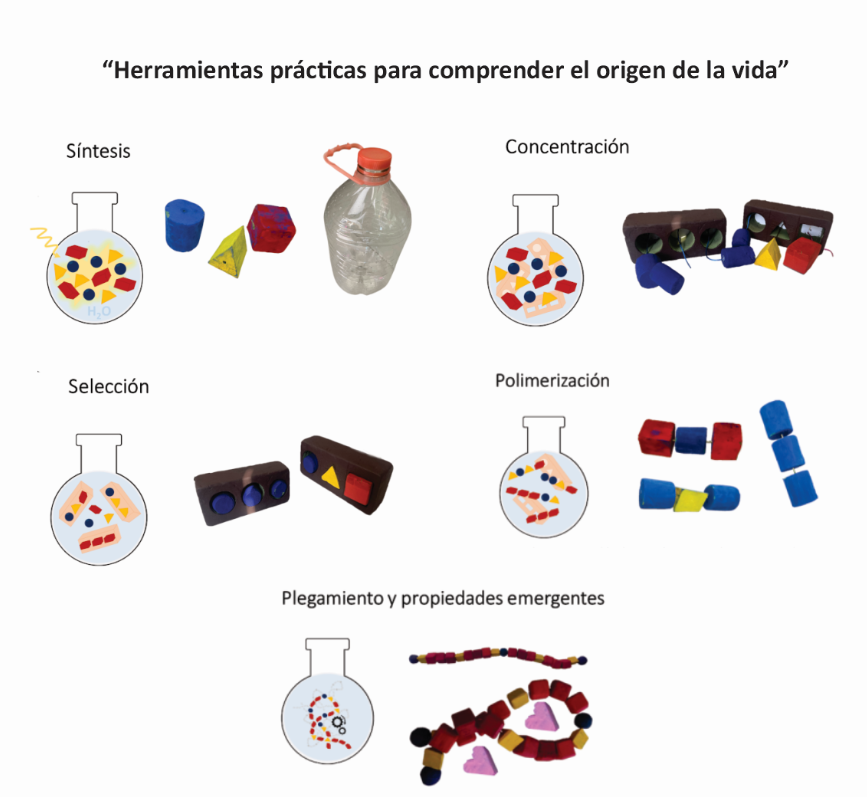Abstract
The origin of life remains a puzzle despite the great scientific advances of the last decades in the areas of prebiotic chemistry, astrobiology, space geology, molecular biology, among many others. This paper explores how prebiotic chemistry, through the study of interaction between minerals and organic molecules, offers clues about the processes that could have led to the emergence of life. A didactic resource is proposed that addresses the interconnected steps that preceded the appearance of the first life forms, from synthesis to the acquisition of emergent properties in organic polymers. This didactic material aims to facilitate the understanding of the origin of life through an accessible and clear presentation of complex concepts, encouraging active learning and reflection on the fundamental processes involved.
References
Baú, J. P. T., Villafañe-Barajas, S. A., da Costa, A. C. S., Negrón- Mendoza, A., Colín-Garcia, M. y Zaia, D. A. (2020). Adenine adsorbed onto montmorillonite exposed to ionizing radiation: Essays on prebiotic chemistry. Astrobiology, 20(1), 26-38.
Bruylants, G., Bartik, K. y Reisse, J. (2011). Prebiotic chemistry: a fuzzy field. Comptes Rendus Chimie, 14(4), 388-391.
Cleaves, H. J. (2012). Prebiotic chemistry: what we know, what we don’t. Evolution: Education and Outreach, 5(3), 342.
Colín-García, M., Villafañe-Barajas, S., Camprubí, A., Ortega-Gutiérrez, F., Colás, V. y Negrón-Mendoza, A. (2018). Prebiotic chemistry in hydrothermal vent systems. Handbook of Astrobiology, 297-329.
Fry, I. (2006). The origins of research into the origins of life. Endeavour, 30(1), 24-28. https://doi.org/10.1016/j.endeavour.2005.12.002
Hazen, R. M. y Sverjensky, D. A. (2010). Mineral surfaces, geochemical complexities, and the origins of life. Cold Spring Harbor Perspectives in Biology, 2(5), a002162-a002162. https://doi.org/10.1101/cshperspect.a002162
Hazen, R. M., Papineau, D., Bleeker, W., Downs, R. T., Ferry, J. M., McCoy, T. J., Sverjensky, D. A. y Yang, H. (2008). Mineral evolution. American Mineralogist, 93(11-12), 1693-1720.
Krishnamurthy, R. (2018). Life’s biological chemistry: a destiny or destination starting from prebiotic chemistry? Chemistry–A European Journal, 24(63), 16708-16715.
Lambert, J.-F. (2008). Adsorption and polymerization of amino acids on mineral surfaces: a review. Origins of Life and Evolution of Biospheres, 38(3), 211-242. https://doi.org/10.1007/s11084-008-9128-3
Miller, S. L. (1953). A production of amino acids under possible primitive Earth conditions. Science, 117(3046), 528-529. https://doi.org/10.1126/science.117.3046.528
Negron-Mendoza, A. y Ramos-Bernal, S. (2004). The role of clays in the origin of life. En Origins: genesis, evolution and diversity of life (pp. 181-194). Springer.
Preiner, M., Asche, S., Becker, S., Betts, H. C., Boniface, A., Camprubi, E., Chandru, K., Erastova, V., Garg, S. G. y Khawaja, N. (2020). The future of origin of life research: bridging decades-old divisions. Life, 10(3), 20.
Zaia, D. A. M. (2012). Adsorption of amino acids and nucleic acid bases onto minerals: a few suggestions for prebiotic chemistry experiments. International Journal of Astrobiology, 11(4), 229- 234. https://doi.org/10.1017/S1473550412000195

This work is licensed under a Creative Commons Attribution-NonCommercial 4.0 International License.
Copyright (c) 2024 Universidad Nacional Autónoma de México

